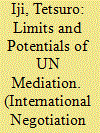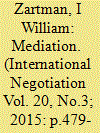| Srl | Item |
| 1 |
ID:
187039


|
|
|
|
|
| Summary/Abstract |
What can UN mediators do to bring warring parties to a negotiated settlement? This article – using ripeness theory – focuses on the parties’ incentives to make a policy shift from war to settlement, and mediators’ influence over such incentives. Mediators can influence through utilizing leverage to create incentives by affecting the parties’ perceived relative power, and through applying intangible resources to facilitate incentive creation without affecting perceived relative power. The constraint on UN mediators is their lack of leverage, while their potential lies in their unique repertoire of intangible resources for facilitative influence. A recurrent limitation of UN mediation manifests where state mediators’ manipulative influence is needed to create the parties’ incentives, and UN mediators’ facilitative influence alone is not enough. On the other hand, UN mediatory potential can be utilized where the parties’ incentives are developed through their own actions and often in the face of pressure and leverage from external patrons.
|
|
|
|
|
|
|
|
|
|
|
|
|
|
|
|
| 2 |
ID:
141716


|
|
|
|
|
| Summary/Abstract |
A mutually hurting stalemate is a necessary but insufficient condition for the opening of negotiations, direct or mediated. It is subject to perception, buffered by many insulating ploys even if it seems to exist objectively. Thus, the major challenge for a mediator in most cases is to ripen the parties’ perceptions. In addition to the attitudinal challenge, there are structural challenges posed by other types of stalemates and near-stalemates, which call for not only persuasion but also manipulation by the mediator. The ultimate challenge to a mediator is to move successful negotiations producing conflict management onto the consummating phase of negotiations for conflict resolution. But the first removes the incentive for the second, since it ceases the violence that is the most effective source of pain.
|
|
|
|
|
|
|
|
|
|
|
|
|
|
|
|